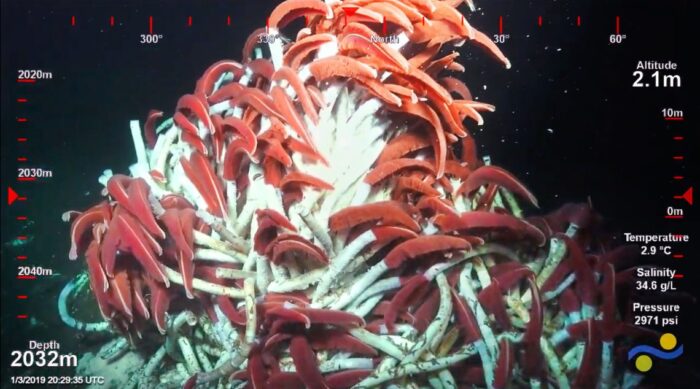It was a moment that changed everything about our understanding of life on Earth. (Including how it probably began!)
We're talking about how research in the late 1970s led to marine biologists discovering hydrothermal vents on the deep sea floor.
These vents, which form chimneys that can look like a cityscape of skyscrapers, are home to a unique category of life. Though these living things live in total darkness, many are able to make their own food using a process known as chemosynthesis. Instead of using sunlight to make food the way that plants and algae do (photosynthesis) they use chemicals in the water.
And now, new research is discovering that this life goes even deeper underground than just vents on the seafloor. Scientists with the Schmidt Ocean Institute dug under a section of volcanic crust in the Pescadero Basin in the Gulf of California. There they revealed an underground community of worms, snails, and bacteria.
How does this world exist in a place not only underground, but deep under the dark sea?
Magma makes it happen

A cluster of giant tubeworms living near a hydrothermal vent. (Schmidt Ocean Institute)
One of the keys to this life is magma, or molten rock.
Many chambers of magma exist underground, created by superheated liquid rock bubbling up from the mantle below. It also warms water and helps to infuse (fill) it with chemicals and minerals that are important to chemosynthesis.
The Earth's crust is not a solid barrier. Instead, it is filled with cracks and tunnels. On the seafloor, water seeps into and travels through these fissures, where it is warmed and loaded with chemicals. It then is released back into the ocean through the hydrothermal vents. Life-giving minerals are deposited all around and huge communities of living things call the area home.
Yay!
Does the life begin underground?
Scientists had long suspected that, just like on land, animals would be found living under the seafloor. They just hadn't really had the chance to test their theory. Until now.
The researchers from the Schmidt Institute set up an experiment about 2,500 metres (8,200 feet) deep, where they cleared a small area of all life. They then placed a mesh box over top of the area, so that nothing could get in from above. The only way into the area would be through tunnels in the crust. (And just to be doubly sure, they released a non-toxic dye into the area, so that any creatures that they had missed clearing out would be coloured red.)
Then they left the mesh box alone for a week and checked back.
What they found was amazing and confirmed their theories. All sorts of new creatures had come in to live in the area. This means that they must have traveled through cracks underground to get there!
Baby worms
Even cooler? Tubeworms are one of the most common forms of life found around hydrothermal vents. But researchers have rarely seen their young, only adult worms.
But in the mesh box experiment, the scientists found baby tubeworms. This means that it is very likely that these creatures start life underground, maturing a little before coming to the surface to grow into adults.
So cool!
And just one example of how much there still is left to discover about life on—and under—the Earth!
Watch members of the research team talk about their experiment in the Pescadero Basin in the video below.
 All sorts of life can be found in the deep sea, such as these octopus, mussels, and tubeworms. (Schmidt Ocean Institute)
All sorts of life can be found in the deep sea, such as these octopus, mussels, and tubeworms. (Schmidt Ocean Institute)








